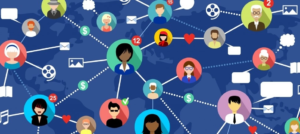Accelerate innovation through communities
As many companies feel the need to accelerate their innovation, we are looking at the role that communities can play in the innovation process. We present four companies that leverage their communities, whether internal, external or mixed, to generate and validate new ideas for original products and services in a collaborative innovation process.

1. Innovation is stagnating in the enterprise
As a major challenge for the company’s development, innovation is currently undergoing a profound and irreversible upheaval. A few years ago, innovation processes were conducted in organizations according to well formalized methods, ensuring the creation and development of new ideas from the R&D laboratory to the market. These methods coordinated the activities of the company’s formal groups (laboratory, engineering, production, marketing, sales…) in project teams, following standardized sequences separated by validation steps. In an increasingly agile mode, this classic form of innovation is no longer sufficient to provide the organization with the knowledge and ideas needed to develop new and adapted solutions.
Companies have realized that innovation will increasingly draw its main source from innovation communities. An innovation community is an informal group made up either of members internal to the companies, or of external members (users of the products and services of these companies, informal virtual groups sharing a common interest, etc.). In these communities, creative ideas emerge, are validated, tested, and implemented via interfaces with the formal structures of the company.
2. Innovation communities
The academic literature has highlighted different types of communities: communities of practice, user communities, virtual communities, communities of interest, epistemic communities, …
A community of practice is made up of a group of members (generally from the same organization) engaged in the same practice, the practice of a profession for example, and communicating regularly with each other on this field of knowledge through mechanisms that can be very diverse: corporate social networks, face-to-face meetings, seminars, webinars, etc. The CoP allows its members to improve their individual skills, through the exchange and sharing of a common directory of resources that are being built as the practice of the community develops.
Communities of users of given products or services are very important potential sources of innovation. Around brands or products, communities of users develop knowledge beyond the boundaries of organizations, such as communities of fans of a technology (Apple…), of video game players (Ubisoft…), of advanced practitioners of a sport (Salomon…). This knowledge is injected into the company’s innovation process.
Communities of interest are centered on members sharing a common interest, such as certain groups rallying around a cause, like the families of Alzheimer’s patients, or the defenders of a threatened ecological site. They can also play a role in innovation for industrial clusters.
Epistemic communities are focused on the deliberate production of new knowledge, such as scientific communities (string theory in astrophysics…) or artistic communities (the Surrealists…).
Internal communities have been known since the 1990s. There are many examples of this in large groups (Schneider Electric, Schlumberger, Engie, Xerox, IBM…). A little later, mixed communities linking the company with stakeholders were studied, such as Toyota’s engineering communities extended to its suppliers. Then companies extended the concept by organizing multi-company idea competitions (open innovation), such as Procter & Gamble. Finally, thanks to the Internet, totally autonomous external communities have emerged, outside any organizational framework, such as the virtual community of enthusiasts who develop the Linux operating system.
In the rest of this article, all these informal groups (communities of practice, epistemological, virtual, etc.) will simply be called “innovation communities”, because in many companies they serve to generate and validate new ideas that form the basis of original products and services.

3. Community Benefits
The main benefit that the community brings to the company is to open access to a source of innovative ideas. Indeed, driven by their passion, community members spontaneously generate ideas all the time. They also have access to the memory of the experiences and ideas of all members.
The internal communities enable to:
- Identify good practices and making the exchange of these practices between members more fluid;
- Tackle the lack of information sharing between departments by reducing the silos that are naturally created between teams isolated by organizational barriers.
Mixed communities make it possible to:
- Broaden points of view by connecting to outside expertise not covered by the company’s existing skills ;
- Generate creative ideas through exchanges between people in the community coming from different backgrounds.
External communities allow to :
- Enrich the company’s products. Community members can contribute new ideas via a crowdsourcing platform. They can also create complements to the company’s products, which they develop, test and share with the community;
- Accelerate product development. This is the case when community members test draft versions of products and give feedback to the company, thus contributing to the development ;
- Spread the buzz around the product thanks to members who relay their enthusiasm on social networks;
- Identify talented people who can then be recruited into the company’s teams.
4. A few examples
Ubisoft has cultivated a strong relationship with multiple communities that infuse a strong dose of creativity into its various video game creation projects. The communities of video game professionals are in touch with the creative communities of the city of Montreal, with whom they exchange ideas in creative venues and at festivals and events that enliven the life of the city. Ubisoft also benefits from the communities of users of its products who contribute to their development. They are also in contact with communities of external specialists, such as the historians who helped develop the Assassin’s Creed series.
Salomon supports the creation and development of communities such as that of trail runners. Thanks to the contributions of the community’s lead-users, Salomon benefits from unexpected inspirations that allow it to enrich its products and maintain an advantage over its competitors.
The SEB Innovation Community of Practice, which brings together 1,300 employees and 30 sub-communities, revolves around an annual event, the Innovation Forum, as well as a series of activities led in each sub-community and orchestrated by the Community of Practice coordinator.
Schneider Electric, aware of the contribution of communities to increase collective intelligence, has decided in 2012 to promote and support the creation of communities of practice piloted through the Communities@Work program. Today, more than 200 communities bring together 30,000 members.

5. Conditions for success
The company must support the community. This means understanding the passion that unites its members, its raison d’être and its practices, respecting its explicit and implicit values, and having an open and transparent dialogue with community members, avoiding jargon.
In the case of internal communities, the company aims to provide support from management for initiatives taken by the community, to facilitate the measurement of the value of the community’s products based, for example, on the appreciation of community members, to help the piloted communities to structure themselves by proposing common tools and operating methods, to create a safe and caring environment in which members will not be judged or criticized for their contribution, and to recognize community participation in the evaluation of employees.
In the case of external communities, the company helps to identify and recognize the roles of contributors in community activities, give members the opportunity to take pride in their activities to inspire other members to come up with new ideas, and establish rules of confidentiality and property rights.
More generally, the company needs to provide resources, for example by freeing up the time of community leaders, encouraging leaders to regularly collect feedback from members to identify community needs and dissatisfactions, and providing tools such as a corporate social network. It can also fund events and projects organized by the community, ensuring that such funding is disinterested or it may be perceived as an attempt to control it. It can provide material means to test rapid prototypes, via internal fab-labs for example, or to open up inspiring spaces for impromptu exchanges.
6. The company at the service of innovation communities
Communities are a very powerful source of innovation for companies. Increasingly, it is a condition for resilience and sustainability. But creating a link between the community and the company is very subtle and counter-intuitive work. The company needs to understand what motivates the community: its passion, its mission and its values. It must apply a new attitude, giving without necessarily expecting an immediate return. It must learn to support the initiatives that interest it, without being able to give the community a direction to follow. It is a new attitude that ensures the resilience and sustainability of 21st century companies.
Louis-Pierre Guillaume
7. To go further
- Playing across the Playground: Paradoxes of Knowledge Creation in the Videogame Firm, Patrick Cohendet et Laurent Simon, Journal of Organizational Behavior, 2007, Vol. 28, No. 5
- Schneider Electric, Next-generation Communities of Practice. Louis-Pierre Guillaume, Coline Delmas and Lauren Trees, APQC 2017
- Communities of Innovation – How Organizations Harness Collective Creativity and Build Resilience, Benoit Sarazin, Patrick Cohendet et Laurent Simon, World Scientific Pub Co Inc , 2021
- Conférence CoP-1 : Les communautés apprenantes dans les grandes organisations , SKEMA BS, 24 novembre 2016
- Innover avec et par les communautés, Un nouveau défi pour les entreprises ! Karine Goglio-Primard, Patrick Cohendet, Bernard Cova et Laurent Simon. Revue française de gestion, 2020/2 N° 287
- Des communautés d’experts internes comme facilitateur de l’innovation, Florence Charue-Duboc, Lise Gastaldi et Emmanuel Bertin, Revue française de gestion, 2020/2 N° 287



Thanks for finally talking about > Accelerate innovation through communities
– Amallte < Liked it!
I love it when folks get together and share ideas.
Great blog, stick with it!
This is really attention-grabbing, You’re an overly skilled blogger.
I have joined your feed and look forward to in search of extra
of your magnificent post. Also, I’ve shared your website
in my social networks
Keep this going please, great job!
I read this post fully on the topic of the resemblance of
hottest and previous technologies, it’s remarkable article.
This article will help the internet viewers for building up new
weblog or even a blog from start to end.
Fascinating blog! Is your theme custom made or did you download it from somewhere?
A design like yours with a few simple tweeks would really make
my blog shine. Please let me know where you got your design.
Kudos
We agree a group of volunteers and starting a new scheme in our community.
Your website offered us with valuable information to work on. You’ve done
an impressive job and our entire community will be thankful to you.